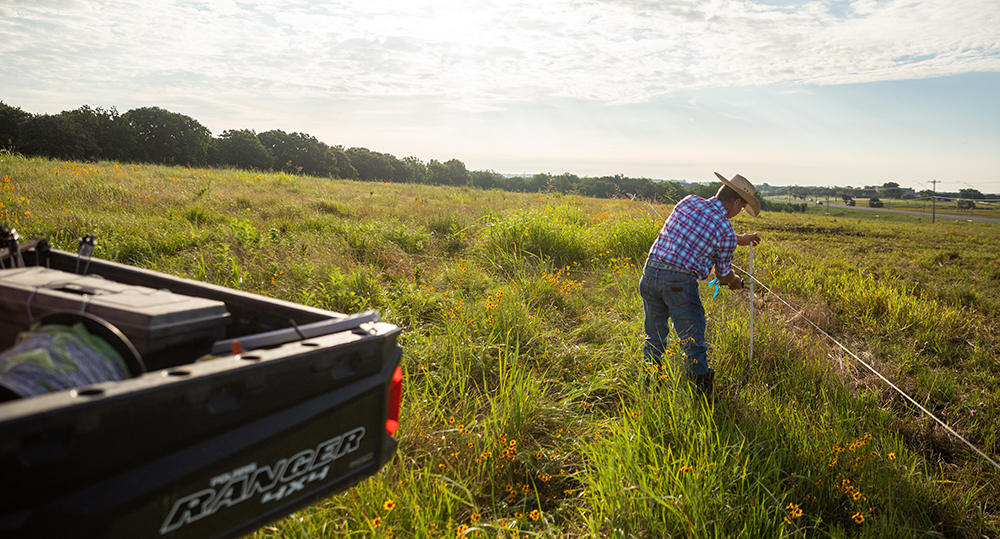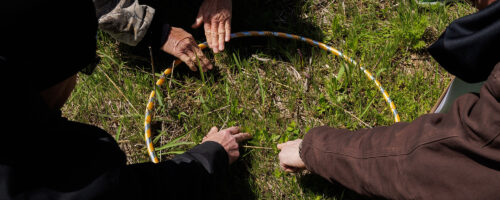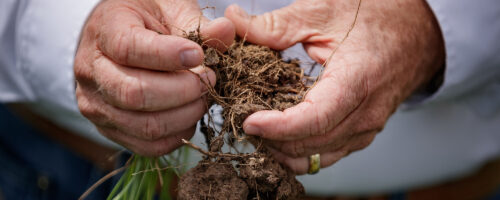Regenerative grazing, also known as adaptive grazing, is a change from the traditional grazing philosophy. It is the intentional mindset of being adaptive and flexible, employing active monitoring and managing for positive change and improved soil health.
Proactive planning and active regenerative grazing management include grazing the appropriate amount of leaf production at the optimal time; encouraging the grazing livestock to uniformly utilize the pasture or paddock; managing grazing to maintain ample residual and allowing full recovery of grazed plants before the next grazing event.
The flexibility of an adaptive system allows and encourages changes in the grazing management of a property from year to year. These changes include:
- Shape and size of grazing paddock
- Stock density (number of animals temporarily grazing an area)
- Duration (length of time an area is grazed)
- Intensity (amount of plant remaining after grazing)
- Frequency (how often it is grazed)
- Time of year
Other considerations are the type of grazing animal species used (cattle, sheep, goats, etc.) and the physiological stage of production of those grazing animals (growing, mature, bred, open, lactating, dry).
You likely already have most of the equipment and facilities you need to get started, so the first and most important step is being open to changing the way you think about and implement grazing on your ranch.

Your regenerative grazing plan
As your mindset toward grazing becomes more adaptive and flexible, you’ll need a plan to implement adaptive grazing. The plan is important because it helps you map the process needed to achieve the desired outcome. The following are 10 aspects to consider and include in a regenerative grazing management plan.
Set goals — Goals are important because they give you outcomes to strive for and help define the practices needed to meet the outcomes. Goals are most impactful when they are developed with all involved parties on the ranch and written down. When developing goals, periodic milestones and steps should be established, noting progress as you implement the plan. This method allows for many smaller victories, providing encouragement along the way. Common grazing goals include improving soil and animal health, increasing plant diversity, reducing brush encroachment, increasing livestock production and increasing profitability.
Develop a support system — Unfortunately, far too many people enter their regenerative journey without the necessary support or guidance. Attempt to locate like-minded individuals to help support you through the process. Use them as sources of information, sounding boards and advisors. Odds are these people went through the same challenges and struggles you are facing now or will face soon. Most of them will be happy to share their experiences and help you grow.
Maps are essential — Aerial photos and soil maps allow you to view the property as a whole and draw in your infrastructure, forage types, etc. Aerial photos can be obtained online from websites such as Google Maps, Google Earth, Daft Logic, etc. There are also numerous apps that can be used on your phone. Local USDA Natural Resources Conservation Service offices also can help provide maps.
Soil maps are useful in determining the different soil types on your property and estimating the forage productivity of an area. Soil differences typically explain why some areas of a property are more productive than others. The USDA Web Soil Survey is an excellent source for soil maps.
Include existing infrastructures — When maps have been developed for the property, draw in any existing infrastructure, such as fences, corrals, water sources (pond and plumbed), roads, paddocks, forage types and other structures. Knowing these locations helps identify areas that need infrastructure development to improve the utilization of the entire property to meet your regenerative grazing goals.
Know existing forage types — Knowing the types of forage on the property and the production of each type is important to determine an appropriate stocking rate. Most pastures have one or multiple species of forages, and knowing the differences between them will help direct your grazing plan. Base forage production numbers on past production records or estimates developed using the Web Soil Survey.

Estimate the number of grazeable acres — Grazeable acres are the areas where the selected grazing animals could forage. To estimate these acres, use an aerial photo website (preferably Google Earth or Daft Logic) or a phone app to outline these areas. If you are grazing the area with cattle, outline the areas not dominated by trees, brush, water or other non-grazeable cover. If goats are used, the entire property, minus water and infrastructure, could be used. Once all areas are drawn, total their areas for the grazeable acres. Be conservative. Overestimating the number of grazeable acres will lead to overgrazing a property.
Determine the correct carrying capacity — Carrying capacity is the quantity of animals the land can support without harming animal performance or the land. Actively managing livestock numbers below the carrying capacity is the most important management decision you can make — regardless of goals. Grazing too many livestock impacts livestock production and every other aspect of the operation and property (soil and plant health, wildlife, economics, etc.).
Overgrazing is a significant cause of poor forage and livestock production, wildlife habitat loss, soil erosion, weed problems and lower profitability on millions of acres across the country. A correctly stocked property provides flexibility in operational management choices, such as wildlife habitat management, prescribed fire implementation, preparation for drought or other adverse weather conditions, or a temporary increase in livestock numbers during years of better-than-average growing conditions. The carrying capacity varies throughout time due to changes in precipitation patterns, plant communities, pasture/ range condition, historical management and other environmental factors.
Determine equipment and infrastructure needs — If you are transitioning from a traditional grazing system to a regenerative grazing system, you may already have much of the equipment you’ll need. In most cases, a system of fences and water sources are already in place. To accommodate the higher stock densities commonly used in regenerative grazing, more temporary fencing is typically required. This additional fencing can be temporary electric fencing constructed with a few geared reels of poly-wire, fiberglass or step-in posts, and a fence charger. You can install and move this fencing on foot, but it is easier to put in longer stretches from a vehicle. Be sure to have a good fence tester.
In some cases, you may need additional water sources to optimize grazing management. There are often cost-share programs through the USDA or nongovernmental organizations available to producers to help offset these costs.
Identify the limiting factors — Determine factors most likely to prevent you from completing your goals. They are different for everyone. Typically, there are several, but identify the most limiting factor first. It could be knowledge, water, quality forage, equipment, money, etc. At Noble, water infrastructure is the limiting factor on many of our properties. Initially, focus your resources and time on that one item. The most limiting factor needing your focus will likely change over time.
Start small to safely learn — Start small before implementing the new grazing management practices across the entire property. Select an area where it will be “safe to learn,” preferably one that already has everything you need to get started, such as reliable water and good fences. Ideally, choose one of your more productive areas, as they are more resilient and will respond more rapidly to good management (and recover sooner should there be an “oops”). This area may only be big enough to graze for a few days, a week or a month.
The thing to remember is that starting small and selecting a safe-to-learn area will allow you to gain knowledge and become comfortable with the practice before gradually scaling it up to the entire property.
Editor’s Note: This is part of a continuing series of articles about regenerative ranching for the American Hereford Association. Follow the series in future issues of Baldy Advantage and Hereford World, as well as in special “1881” podcasts, at Hereford.org.


Comment
Leave a Reply
3 comment on: "Intentional Improvement""

brad
May 13, 2025any NRI action/news with respect to Virginia?
Noble Research Institute
May 14, 2025We are currently conducting research through the country, you can read about it here: Metrics, Management, & Monitoring (3M). I do not believe we have any participants from Virginia, but we do have NE representation.
Taner
August 15, 2025Very Informative